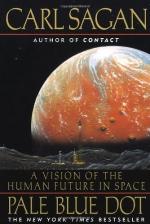
|
| Name: _________________________ | Period: ___________________ |
This test consists of 15 multiple choice questions and 5 short answer questions.
Multiple Choice Questions
1. What is notable about pictures taken of the Earth from the moon?
(a) The Earth is always in a half-eclipse.
(b) No landmasses can be seen.
(c) There is no visible sign of mankind.
(d) The Earth appears completely dark.
2. What role does Sagan suggest that religion has played in the development of science?
(a) Science progressed in spite of religion.
(b) Religion informs and guides scientific development.
(c) Religion has aided science in significant ways.
(d) Religiously-minded individuals often become scientists.
3. What criticism does Sagan make of NASA in Chapter 6, "The Triumph of Voyager"?
(a) It is essentially incompetent.
(b) It has made many engineering mistakes.
(c) It cannot correct its mistakes.
(d) It is unconcerned with human safety in spaceflight.
4. Sagan describes humans as which of the following, with respect to their arrival in the universe?
(a) Middling achievers.
(b) Early adopters.
(c) Extreme latecomers.
(d) Slow movers.
5. How does Sagan describe his reaction to the difficulties in detecting human life and intelligence on Earth from space?
(a) Sobering.
(b) Disappointing.
(c) Aggravating.
(d) Unsurprising.
6. What planet represents the farthest distance from Earth that the Voyager craft were intended to function at?
(a) Uranus.
(b) Mars.
(c) Jupiter.
(d) Saturn
7. Sagan suggest that modern religious thinking treats scientific evidence in what way?
(a) It blatantly disregards the evidence.
(b) It makes no statements about the evidence.
(c) It intrudes on the evidence.
(d) It is cautious about the evidence.
8. What is Neptune's largest moon?
(a) Triton.
(b) Eurydice.
(c) Ariadne.
(d) Europa.
9. What punishment did Galileo suffer as a result of his works?
(a) He was put under permanent house arrest.
(b) He was imprisoned for life.
(c) He was burned at the stake.
(d) He was beheaded.
10. What was the state of the knowledge and belief about life on other planets at the time the book was written?
(a) Scientists expected to find life on most of the planets and moons.
(b) It was believed there was abundant life on Mars.
(c) Most believed life on other planets was impossible.
(d) No signs of life were known to exist.
11. William Herschel, the discoverer of Uranus, had what unusual profession?
(a) Musician.
(b) Actor.
(c) Magician.
(d) Poet.
12. What major change have humans made to the environment that would be easily detectable from space?
(a) Desertification.
(b) The destruction of the rainforests.
(c) The Three-Gorges dam.
(d) The pollution of rivers and lakes.
13. How likely does Sagan think it is that the records on Voyager will eventually be found?
(a) It is almost impossible.
(b) It is reasonably likely.
(c) It is almost certain.
(d) It is unlikely.
14. Sagan helped to discover that Saturn provides what critical element to Titan?
(a) Hydrogen.
(b) Energy.
(c) A magnetosphere.
(d) Tidal forces.
15. What is one trait of human beings that Sagan cites as being responsible for our belief in our importance in the universe?
(a) Insecurity.
(b) Ignorance.
(c) Creativity.
(d) Industry.
Short Answer Questions
1. What astronomical discovery did Galileo make that significantly damaged the geocentric theory?
2. What does Neptune posses at its core that Uranus apparently lacks?
3. Which other nation besides the United States led the way in space exploration?
4. What does Sagan say that philosophy and religion should provide?
5. Titan orbits what planet?
|
This section contains 524 words (approx. 2 pages at 300 words per page) |

|




